|
| |
|
From a Bare
Hull: Interior
Basics (Page
5)
|
V Berth and Settee Structure (Continued)
The next step was to cut and install the plywood platforms, or tops, of
the V-berth and settees in the cabin. I made these from sheets of 9mm
Meranti plywood.
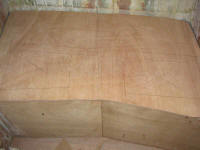 I
began with the twin settees, located between the chainplate bulkhead and the
mid bulkhead, which also delineates the aft end of the cabin area.
Since the two edges of these platforms were straight, as defined by the
bulkheads, fitting them was relatively straightforward once I cut plywood to
the proper width. Sliding the raw platform into place and as far
outboard as possible, I could then scribe the contours of the hull on the
outboard side. With one or two additional fittings and minor
adjustment, the cuts were complete. I cut the inboard edge of each
piece a little oversize, to be trimmed off later. I repeated this
process on the other side, and then spent some time marking out for some
access hatches to be cut. I
began with the twin settees, located between the chainplate bulkhead and the
mid bulkhead, which also delineates the aft end of the cabin area.
Since the two edges of these platforms were straight, as defined by the
bulkheads, fitting them was relatively straightforward once I cut plywood to
the proper width. Sliding the raw platform into place and as far
outboard as possible, I could then scribe the contours of the hull on the
outboard side. With one or two additional fittings and minor
adjustment, the cuts were complete. I cut the inboard edge of each
piece a little oversize, to be trimmed off later. I repeated this
process on the other side, and then spent some time marking out for some
access hatches to be cut. |
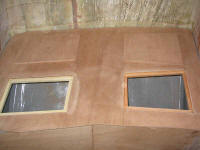 I
cut out each hatch opening carefully, and drilled finger holes in each at
the drill press. Then, I cut and fit cleats to the underside of the
openings, which would support the simple hatches. I installed the
cleats with wood glue and bronze screws, and routed a chamfer on the inside
bottom edge so that no sharp corners would be encountered when accessing the
lockers beneath. I left the new settees loosely installed for the
moment, and continued on with the V-berth platforms. I
cut out each hatch opening carefully, and drilled finger holes in each at
the drill press. Then, I cut and fit cleats to the underside of the
openings, which would support the simple hatches. I installed the
cleats with wood glue and bronze screws, and routed a chamfer on the inside
bottom edge so that no sharp corners would be encountered when accessing the
lockers beneath. I left the new settees loosely installed for the
moment, and continued on with the V-berth platforms. |
|
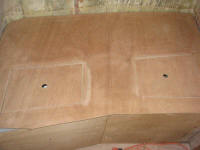
|
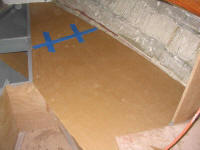 The
V-berth was a bit more complex, and required making a cardboard pattern of
one side. With room to overhang the centerline, I used two large
cardboard sheets and roughed out a pattern of the starboard half of the
berth, which I then refined using a scribe and cutting it down to fit. The
V-berth was a bit more complex, and required making a cardboard pattern of
one side. With room to overhang the centerline, I used two large
cardboard sheets and roughed out a pattern of the starboard half of the
berth, which I then refined using a scribe and cutting it down to fit. |
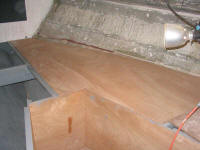 I
transferred the shape of the pattern to a piece of plywood and cut it out
with a jigsaw. It took some minor adjustment and recutting before the
piece fit properly in place in the V-berth. Then, I made some minor
adjustments to the cardboard pattern so that it would fit on the port side,
and cut out a second piece of plywood to match; I found that I could cut
both pieces from a single sheet of plywood with minimal waste. I
transferred the shape of the pattern to a piece of plywood and cut it out
with a jigsaw. It took some minor adjustment and recutting before the
piece fit properly in place in the V-berth. Then, I made some minor
adjustments to the cardboard pattern so that it would fit on the port side,
and cut out a second piece of plywood to match; I found that I could cut
both pieces from a single sheet of plywood with minimal waste. |
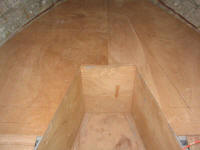 With
both pieces loosely installed, I made some marks for access hatches, and
then cut and installed cleats for the hatches as described above. With
both pieces loosely installed, I made some marks for access hatches, and
then cut and installed cleats for the hatches as described above. |
|


|
Finally, I permanently
installed the settee and V-berth tops. There were four pieces to
install; I installed them one by one, each time following the same basic
process.
 My first step was to lay down
a bead of all-weather construction adhesive. I chose this product
because it is extremely strong, weatherproof, and inexpensive--perfectly
suited for securing panels and interior sections. Using a caulking
gun, I laid the bead on all mating surfaces, including the cleats along the
hull, the plywood structural members, and the additional wooden cleats and
other supports secured elsewhere. My first step was to lay down
a bead of all-weather construction adhesive. I chose this product
because it is extremely strong, weatherproof, and inexpensive--perfectly
suited for securing panels and interior sections. Using a caulking
gun, I laid the bead on all mating surfaces, including the cleats along the
hull, the plywood structural members, and the additional wooden cleats and
other supports secured elsewhere. |
After carefully laying the section into the bead of adhesive, I secured the
pieces with countersunk #8 x 1" bronze screws. I repeated this process
for each of the two sections of the V-berth, and for the two settee tops.
This pulled the plywood tightly into the adhesive. |
When all sections were glued and screwed into place, I set up my router with
a flush trimming big, and trimmed the overhanging edges of the plywood; I
finished up with a handsaw where the router couldn't reach. Then, I
left the pieces to cure in their adhesive overnight. |
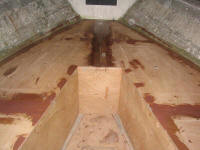 The next day, I continued by installing fiberglass tabbing along the various
edges where the interior structure adjoined the hull and bulkheads. I
used 15 oz. biaxial tape (4") set in epoxy resin for this. This
tabbing was not structural for the strength of the boat, but served to
reinforce and secure the edges of the interior structures. When the
new fiberglass had had sufficient time to cure, I sanded it to remove any
rough spots and prepare it for later painting. The next day, I continued by installing fiberglass tabbing along the various
edges where the interior structure adjoined the hull and bulkheads. I
used 15 oz. biaxial tape (4") set in epoxy resin for this. This
tabbing was not structural for the strength of the boat, but served to
reinforce and secure the edges of the interior structures. When the
new fiberglass had had sufficient time to cure, I sanded it to remove any
rough spots and prepare it for later painting. |
With that, the basic bones of the interior were in place. The next
interior steps include installing cleats for hull ceilings, storage lockers
and backrests on the settees, and other minor projects. But my main
goal of completing the major interior structures before building and
covering the cabin trunk had been achieved.
Click here to continue
with interior work> |
|
|
|
